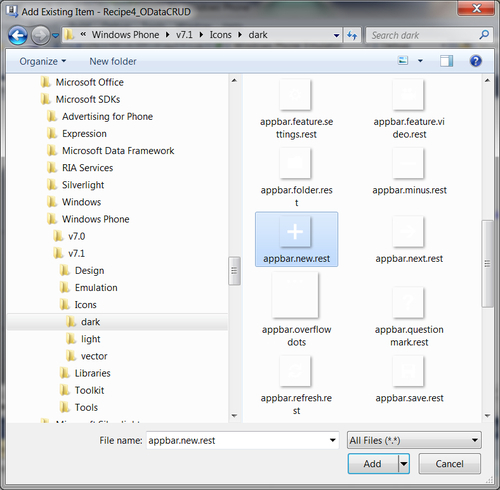In this recipe we will discuss how to implement create, update, and delete operations, also known as CRUD operations using DataServiceCollection and Context class. Here are the mappings for HTTP Verb to OData operation:
|
HTTP |
OData |
|---|---|
|
GET |
Read |
|
POST |
Update |
|
PUT |
Insert |
|
DELETE |
Delete |
For this sample, we will be using the editable OData API exposed by odata.org. Just a note, at the time of writing the book this service was provided for testing OData edit features with some restrictions.
You can browse OData using http://services.odata.org/(S(bltvbobia1rthiavqczdcr1u))/OData/OData.svc/. We will be using this link to consume the data in this recipe. For simplicity, we shall only update the categories.
To consume sample editable OData, we first need to generate the proxy class using the DataSvcUtil using the following command-line:
datasvcutil /uri:http://services.odata.org/(S(bltvbobia1rthiavqczdcr1u))/OData/OData.svc/ /out:.EditODataModel.cs /Version:2.0 /DataServiceCollection

- Right-click on the solution folder
Ch4_Recipesand add a new Phone Project with a nameRecipe4_ODataCRUD. - Now add the proxy class
EditODataModel.cswe generated into the project by right-clicking and selecting Add Existing Item. You can also use Windows Explorer to just copy and paste the file into the project. - Add a reference to the assembly
System.Data.Services.Clientthat comes with the SDK to the project. - Open the
MainPage.xamlfile and let's add aListBoxcontrol with two text blocks, one for Category ID and another for Category Name. Add theBindingproperty to both of them. Also, add theSelectionChangedevent for theListBox. Right-click on OnSelect and click on Navigate to Event Handler to create the emptyOnSelectevent method:<Grid x:Name="LayoutRoot" Background="Transparent"> <Grid.RowDefinitions> <RowDefinition Height="Auto"/> <RowDefinition Height="*"/> </Grid.RowDefinitions> <!--TitlePanel contains the name of the application and page title--> <StackPanel x:Name="TitlePanel" Grid.Row="0" Margin="12,17,0,28"> <TextBlock x:Name="ApplicationTitle" Text="Ch4 Recipes" Style="{StaticResource PhoneTextNormalStyle}"/> <TextBlock x:Name="PageTitle" Text="OData CRUD" Margin="9,- 7,0,0" Style="{StaticResource PhoneTextTitle1Style}"/> </StackPanel> <!--ContentPanel - place additional content here--> <Grid x:Name="ContentPanel" Grid.Row="1" Margin="12,0,12,0"> <ListBox x:Name ="lstResults" Grid.Row="3" Grid.Column ="1" ItemsSource="{Binding}" SelectionChanged="OnSelect"> <ListBox.ItemTemplate> <DataTemplate> <Grid> <Grid.RowDefinitions> <RowDefinition Height="*" /> <RowDefinition Height="*" /> </Grid.RowDefinitions> <Grid.ColumnDefinitions> <ColumnDefinition Width="20"/> <ColumnDefinition Width="*" /> </Grid.ColumnDefinitions> <TextBlock Grid.Row="0" Grid.Column="0" Text="{Binding ID}" FontWeight="Bold" Foreground="OrangeRed"/> <TextBlock Grid.Row="0" Grid.Column="1" TextWrapping="Wrap" Text="{Binding Name}" FontWeight="Bold" FontStretch="Expanded" Foreground="OrangeRed"/> </Grid> </DataTemplate> </ListBox.ItemTemplate> </ListBox> </Grid> </Grid> - Windows Phone 7.1 SDK comes with most commonly used icons. Create a new folder in the project and name it
Images. Now right-click on theImagesfolder and select Add Existing Items. Navigate to your local driveProgram FilesMicrosoft SDKsas shown in the following screenshot and selectappbar.new.rest.png.
- After the grid, add the
ApplicationBarat the bottom to display one icon to add a newCategory. Also, add the click event to map to theButtonAdd_Clickmethod:<phone:PhoneApplicationPage.ApplicationBar> <shell:ApplicationBar BackgroundColor="Orange" IsVisible="True" IsMenuEnabled="True"> <shell:ApplicationBarIconButton IconUri="/Images/appbar.new.rest.png" Click="ButtonAdd_Click" Text="Add Task"/> </shell:ApplicationBar> </phone:PhoneApplicationPage.ApplicationBar>
- Open the
MainPage.xaml.csfile and include the followingusingdeclarations at the beginning of the page:using ODataDemo; using System.Data.Services.Client; using System.Windows.Controls.Primitives;
- Let's add the following variables just before the
MainPageconstructor:private Uri svcUri; private ODataDemo.DemoService ctx; private DataServiceCollection<ODataDemo.Category> rslts;
- Next, add the following code to the
MainPagemethod. Here we are creating the instance of theUriand calling theDemoService. Similar to the last recipe, we will save theCategorycollections in theDataServiceCollectionand callLoadAsync:public MainPage_Loaded(object sender, RoutedEventArgs e) { svcUri = new Uri(@"http://services.odata.org/ (S(bltvbobia1rthiavqczdcr1u))/OData/OData.svc/"); var query = "Categories"; // create context ctx = new ODataDemo.DemoService(svcUri); rslts = new DataServiceCollection<ODataDemo.Category>(ctx); rslts.LoadCompleted += new EventHandler <LoadCompletedEventArgs>(rslts_LoadCompleted); rslts.LoadAsync(new Uri(query, UriKind.Relative)); } - Let's add the method
rslts_LoadCompleted. Here we check for any errors, otherwise we assign the query results to theDataContext:private void rslts_LoadCompleted(object sender, LoadCompletedEventArgs e) { if (e.Error == null) { this.DataContext = rslts; } else { MessageBox.Show(string.Format("Error: {0}", e.Error.Message)); } } - Now let's add the code in the
OnSelectevent method. Here we get theSelectedIndexand pass it as a query string. This is used for selecting:private void OnSelect(object sender, SelectionChangedEventArgs e) { var selector = (Selector)sender; if (selector.SelectedIndex == -1) return; this.NavigationService.Navigate(new Uri("/CategoryForm.xaml?selIndex = " + selector.SelectedIndex, UriKind.Relative)); selector.SelectedIndex = -1; } - Next, we added the toolbar at the bottom for adding new items. Let's add the method to navigate to
CategoryForm.xamlwith query stringselIndexas zero. The reason for zero is to indicate that it is a new category:private void ButtonAdd_Click(object sender, EventArgs e) { this.NavigationService.Navigate(new Uri("/CategoryForm.xaml?selIndex = 0", UriKind.Relative)); } - Now let's add a new page called
CategoryForm.xamlto the project. As this is for updating theCategorycollection, let's add two textboxes and a save button, which would look like the following code snippet:<Grid x:Name="LayoutRoot" Background="Transparent"> <Grid.RowDefinitions> <RowDefinition Height="Auto"/> <RowDefinition Height="*"/> </Grid.RowDefinitions> <!--TitlePanel contains the name of the application and page title--> <StackPanel x:Name="TitlePanel" Grid.Row="0" Margin="12,17,0,28"> <TextBlock x:Name="ApplicationTitle" Text="Edit OData App" Style="{StaticResource PhoneTextNormalStyle}"/> <TextBlock x:Name="PageTitle" Text="Category" Margin="9,-7,0,0" Style="{StaticResource PhoneTextTitle1Style}"/> </StackPanel> <!--ContentPanel - place additional content here--> <Grid x:Name="ContentPanel" Grid.Row="1" Margin="12,0,12,0"> <TextBlock Height="30" HorizontalAlignment="Left" Margin="28,43,0,0" Name="textBlock1" Text="ID" VerticalAlignment="Top" Width="115" /> <TextBox Height="72" HorizontalAlignment="Left" Margin="12,68,0,0" Name="txtID" Text="" VerticalAlignment="Top" Width="438" /> <TextBlock Height="30" HorizontalAlignment="Left" Margin="28,146,0,0" Name="textBlock2" Text="Name" VerticalAlignment="Top" Width="115" /> <TextBox Height="72" HorizontalAlignment="Left" Margin="12,171,0,0" Name="txtName" Text="" VerticalAlignment="Top" Width="438" /> <Button Content="Save" Height="72" HorizontalAlignment="Left" Margin="12,249,0,0" Name="button2" VerticalAlignment="Top" Width="136" /> </Grid> </Grid> - Now, open the
CategoryForm.xaml.csfile and add ausingdeclaration at the top of the page forODataDemo:using ODataDemo;
- Next, we need to hold the new form data and when the Save button is clicked it should be accessed in the
MainPageso it is added to theDataServiceCollection. We can achieve this by either serializing the object to local storage, or just holding a global static variable. Open theApp.xaml.csfile and add static variable_category:public static ODataDemo.Category _category;
- When the user clicks the Save button, we save the
IDandNameto the global variable and then navigate back to the previous page:private void btnSave_Click(object sender, RoutedEventArgs e) { App._category = new Category(); if (txtID.Text != "") App._category.ID = int.Parse(txtID.Text); if (txtName.Text != "") App._category.Name = txtName.Text; NavigationService.GoBack(); } - Now open the
MainPage.xaml.csfile and add theOnNavigatedTomethod. In this method, we check if there is anything in the static variable and then add the category object to the collection.// called when the current frame becomes active protected override void OnNavigatedTo(System.Windows.Navigation. NavigationEventArgs e) { if (App._category != null) { rslts.Add(App._category); } base.OnNavigatedTo(e); } - Let's go back to
CategoryForm.xaml.csand add theOnNavigatedTomethod here too. Before the method, declare the string variableselIndex. We will get the query stringselIndexusing theNavigationContextclass. We will use this variable in the page-loaded event method to get the collection item.private string selIndex; protected override void OnNavigatedTo (System.Windows.Navigation.NavigationEventArgs e) { base.OnNavigatedTo(e); if (!NavigationContext.QueryString.TryGetValue("selIndex", out selIndex)) { MessageBox.Show("Error"); } } private void PhoneApplicationPage_Loaded(object sender, RoutedEventArgs e) { if (int.Parse(selIndex) != 0) { txtID.Text = App._category.ID.ToString(); txtName.Text = App._category.Name.ToString(); } } - Now, press F5 and run. You should see the list of categories and when you select the category name you will be navigated to
CategoryFormto edit and save. You can also click on the + button in the navigation bar to save a new category.
First, we displayed the list of categories available in the OData list. By getting the list using DataServiceCollection and context classes, we are making use of the automatic tracking for changes to the list.
By updating the object it is marked as changed. OData automatically updates the OData data source. We can add to and update the collection using DataServiceCollection's add and update methods. Just like adding to and updating the collection, we can also remove from the collection.
You can easily navigate the structure of OData using free tools available online.
There are many different explorers available online for browsing the OData:
- OData Explorer by Microsoft:
http://www.silverlight.net/content/samples/odataexplorer/default.html
- SESAME Data Browser also supports OData. At the time of writing this book, this was still a BETA:
- LINQPad is another choice that supports OData:
Check Chapter 6 for REST web services and Chapter 7 for WCF web services.
Also, check the following online resources for further understanding of OData:
- Consuming OData with MVVM for Windows Phone:
http://msdn.microsoft.com/en-us/library/hh394007(v=VS.92).aspx
- Building great experiences on any device with OData:
- Updating OData data sources from WP7 9 (OData Azure Service).
http://samidipbasu.com/2011/07/24/updating-odata-data-source-from-wp7-part-1/
